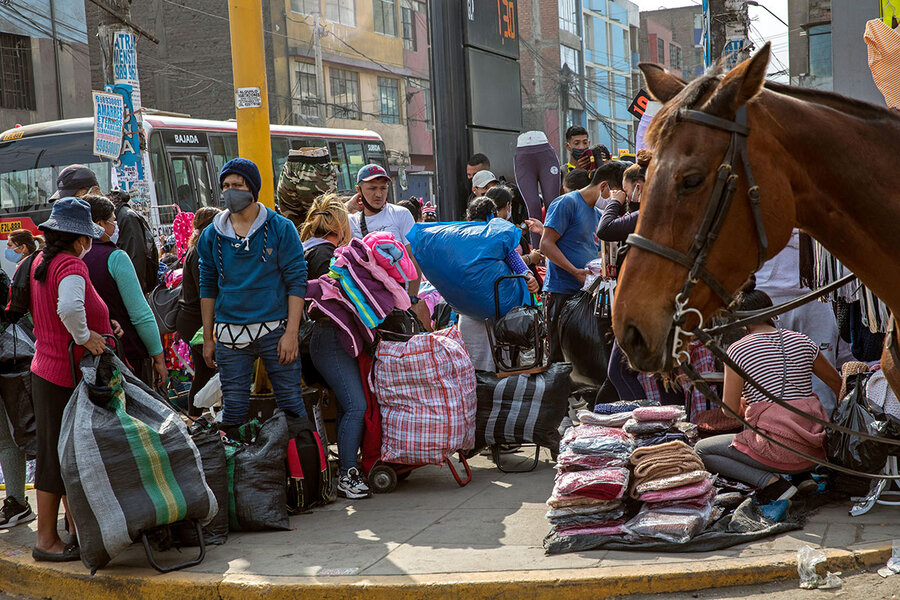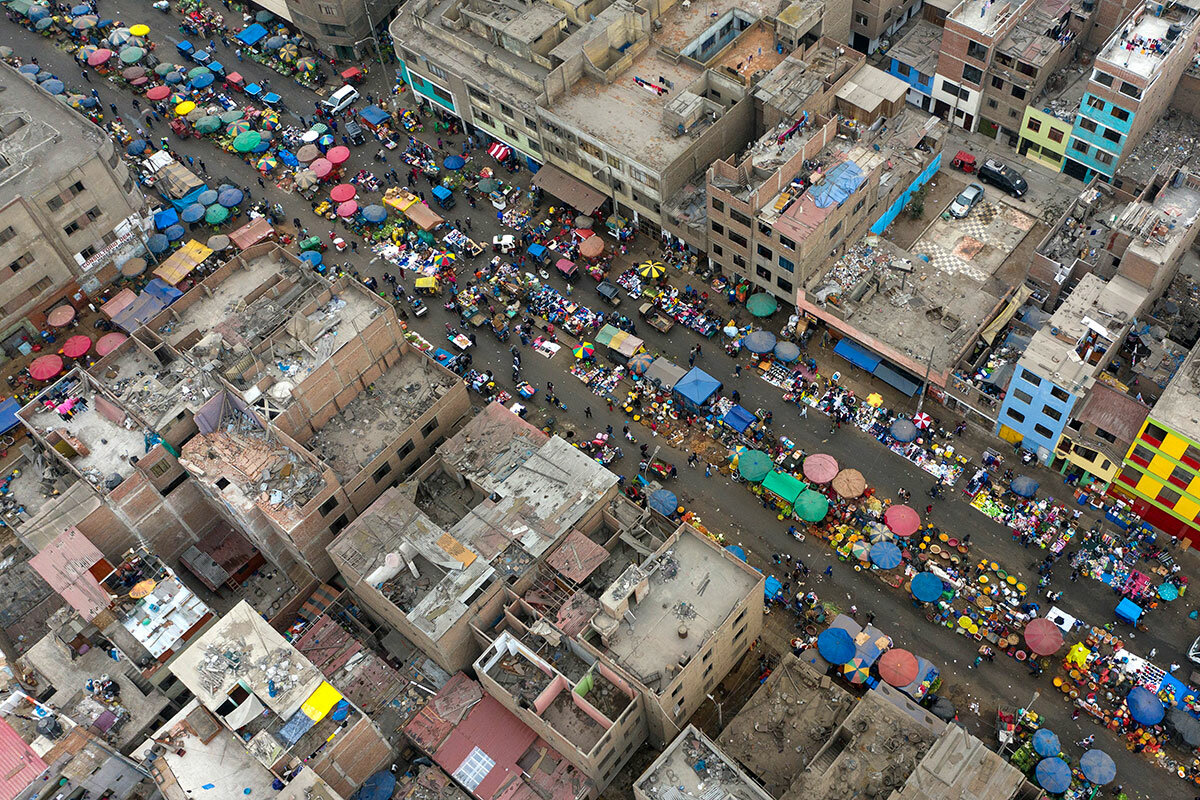‘We’re invisible’: Peru’s moment of reckoning on informal workers
Loading...
| Mexico City
Early this spring, Peru was lauded for its quick action against COVID-19 – and not only in terms of health. The government designed an economic relief package that included vital cash transfers for poor, vulnerable, and self-employed people.
Yet today, Peru has one of the world’s longest lockdowns, and many people have yet to receive any assistance. What’s more, the country has the second-highest tally of COVID-19 cases in Latin America. Where things went wrong, experts say, was in misunderstanding the dynamics of poverty in a country that has gained “middle-income” status over two decades of growth. Particularly hidden are the 70% of Peruvian workers who labor in the informal sector – many of whom lack bank accounts, too.
Why We Wrote This
For two decades, Peru charted its own success story, as millions joined the middle class. But challenges delivering lockdown relief are highlighting just how partial that success has truly been. Part 2 of “One pandemic, many safety nets: A global series.”
“It’s like we decided poverty is almost over in [Peruvian] cities and we only need to focus on rural areas,” says Carmen Roca of WIEGO, an international NGO advocating for informal workers. The pandemic “is exposing the fact that there are still a lot of people in poverty who we didn’t see before.”
Challenges in identifying who is in need won’t be resolved overnight, she says, but hopefully the pandemic will set priorities moving forward.
“This population working informally, in a sense, they have finally been seen and recognized,” Ms. Roca says.
When Luis David Arias Gutiérrez first learned of Peru’s strict coronavirus lockdown, the Lima-based street vendor supported it.
Sure, it would be tough. Like the staggering 70% of Peruvian workers that labor in the informal sector, the notebook and school-supply salesman lived largely day to day, without much savings to fall back on. But the government, it seemed, knew what it was asking of workers like him.
Peru set a global example of quick action in the face of COVID-19, implementing a nationwide lockdown March 16, soon after its first confirmed case. The government invested in respirators and hospital beds, and offered bonuses to medical professionals. It designed an economic relief package that not only offered low-interest loans to businesses and helped employers keep workers on payrolls, but also targeted the poor, vulnerable, and self-employed with vital cash transfers.
Why We Wrote This
For two decades, Peru charted its own success story, as millions joined the middle class. But challenges delivering lockdown relief are highlighting just how partial that success has truly been. Part 2 of “One pandemic, many safety nets: A global series.”
But today, more than three months later, Mr. Arias feels tricked.
“The state hasn’t done anything to help me. Not with cash transfers, not with food donations,” says Mr. Arias, who previously earned about $14 a day.
Editor’s note: As a public service, all our coronavirus coverage is free. No paywall.
He made it through one and a half months of lockdown before heading back to the streets. He and hundreds of other vendors on the block had their wares confiscated by municipal officials, and were told that to get them back, they would need to pay a set fine for breaking the lockdown, which, for some vendors, was double the value of the merchandise itself.
“When the option is to die of hunger or hope that this illness doesn’t get you, of course you break quarantine to try and feed your family,” he says. As leader of a local informal street merchant association, he knows scores of vendors who have fallen ill. Public markets have become hot spots, with nearly 8 in 10 vendors testing positive in one fruit market alone.
Despite Peru’s lauded response efforts, it now has one of the world’s longest lockdowns, and the second-highest tally of COVID-19 cases in Latin America, with more than 264,000 cases and more than 8,000 people killed. In the region, Peru ranks only behind Brazil, which has taken a decidedly less deliberate approach to halting the pandemic. Where things went wrong, experts say, was in misunderstanding the dynamics of poverty in a country that has gained “middle-income” status over two decades of growth.
“It’s like we decided poverty is almost over in [Peruvian] cities and we only need to focus on rural areas,” says Peru-based Carmen Roca, the Latin America regional advisor for WIEGO, an international nongovernmental organization advocating for informal workers. The pandemic “is exposing the fact that there are still a lot of people in poverty who we didn’t see before: They are earning day to day and working in difficult conditions.”
Missing numbers
In a region known for economic booms and busts, Peru has been a model of steady economic success, bolstered by commodity exports and conservative fiscal policies. Millions have moved out of poverty. But that progress may have given Peruvians a false sense of security.
“For 20 years we’ve been a star country in terms of macroeconomics. We’ve grown extraordinarily, had fiscal discipline,” says Hugo Ñopo, an economist at Grade, a development think tank in Lima. “But we’ve forgotten to invest in the people. We’ve forgotten to invest in health and education.”
Peru’s $26 billion relief package is worth an estimated 12% of the country’s gross domestic product. (In comparison, the U.S. is spending about 14% of its GDP.) But reaching vulnerable households with the transfers of 380-760 soles ($110-$220) has proved challenging – particularly given outdated information on who is struggling. After Peru first announced subsidies for poor people and informal workers, so many people were accidentally excluded that two new transfer programs were created, using information from other agencies.
It isn’t for lack of trying, observers say. The government used various databases, but it became obvious early on that numbers on poverty were out of date, says Mr. Ñopo, who co-wrote a United Nations Development Program policy note on Peru’s relief package.
“Errors are unavoidable. But this is the moment when we have to learn from these mistakes,” he says. “The government needs to adapt – see the error as a tool for excellence” moving forward.
“We can’t keep running on autopilot,” Mr. Ñopo says.
The shortcomings of Peru’s ambitious package reflect the “fragility of our safety nets,” former finance minister Luis Miguel Castilla said in an April 15 online conference hosted by the Wilson Center. “Peru lacks the tools to reach vulnerable populations,” including bank accounts – only 43% of the population has one.
NGOs like WIEGO offered to create a roster of its own to share with the government, but Ms. Roca says they were rebuffed. She suspects that, given high-profile corruption scandals in recent years, the government’s hands were tied on what kind of databases to use.
Corruption has also been to blame for some of the poor execution. Food baskets, for example, were to be distributed at the municipal level, and the government has received hundreds of complaints of irregularities, like expired products or goods removed before delivery.
Ms. Roca says the challenges in identifying who is in need clearly won’t be resolved overnight, but hopefully the pandemic will set priorities moving forward.
“This population working informally, in a sense, they have finally been seen and recognized,” Ms. Roca says.
“We’re invisible”
Before COVID-19, Gloria Solórzano worked two informal jobs, starting around 4 a.m. each day. She’d sell fresh fruit, bringing home roughly $10, in the morning, and embroider in the afternoons. But she’s over 60 and says going out to work is too risky. She feels lucky that her adult children are helping her where they can, but they too are now without an income.
The day to day is grim: Ms. Solórzano eats one meal, down from two or three a day pre-pandemic. “The situation here is really critical, more so than in other countries, because the government isn’t taking us into account. We’re invisible,” she says of informal workers. She’s the leader of the National Network of Self-Employed Workers (RENATTA), with roughly 2,000 members. She knows of three who have received a government transfer.
Meanwhile, unemployment has exploded, growing to 13.1%.
“Informal workers will multiply,” Ms. Solórzano predicts. “It will be really hard to subsist. It’s not just me – it will be our reality at the national and international level. How will we move ahead after this pandemic?”
Editor’s note: As a public service, all our coronavirus coverage is free. No paywall.











